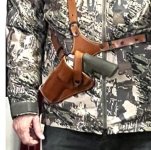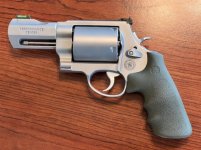dwever
Member
When I carried an S&W 44 Magnum in the wilderness it was good protection in the South Eastern US. I moved to Alaska and found sometimes more power is needed; but, I also discovered the 460 X-Frame revolver which can become a mild mannered 44 Magnum simply by loading 45 Colt +P Heavy (see pictures), or for some thing warmer a light 454 Casull Underwood Xtreme Penetrator (250 grain 1512 ft. Lbs.), or for something hot, a 454 Casull Heavy at 1800 ft. lbs, or for big bear protection, .460 Buffalo Bore Dangerous Game at 2,455 ft. lbs.
In other words, starting at 300 grains and 1100 ft. Lbs., you can walk right up to 2,800 lbs in as small of increments as you want. I stop at the Buff Bore 300 grain 2,455 ft. Lbs. as that is as hot as I can shoot the snub without punishment. I’m loaded with a milder .460 300 Grain Underwood 2,040 ft. Lbs. XTP JHP now that the bears are asleep. I also often wear in ear electronics on foot.
Pretty amazing platform this .460 XVR. Functionally more than one weapon without having to swap cylinders like with a Korth .357/9mm.
I alternate between a Galco Great Alaskan, Diamond Guide’s Choice (shown), and a cross draw with dedicated 1 3/4” inch belt for quick on and off. Nill grips. The 3.5” barreled X-frame stays with me. Now have a second .460 with 8 3/8” barrel with Galco Kodiak. It doesn’t get out much.
While S&W delivered the weapon initially w/the wrong front site and I swapped it at my own cost, the weapon has been a delight since.
L to R:
*44 Magnum Heavy for comparison
*45 Colt +P, 454 Casull .46O S&W
*Three .460 S&W Bullets L to R: Hornady 460 200 Grain FTX, Underwood 460 250 Grain XTP JHP, Buff Bore 460 Dangerous Game Mono-metal
*S&W PC 460 with Nill Grips
*Diamond Guide’s Choice
In other words, starting at 300 grains and 1100 ft. Lbs., you can walk right up to 2,800 lbs in as small of increments as you want. I stop at the Buff Bore 300 grain 2,455 ft. Lbs. as that is as hot as I can shoot the snub without punishment. I’m loaded with a milder .460 300 Grain Underwood 2,040 ft. Lbs. XTP JHP now that the bears are asleep. I also often wear in ear electronics on foot.
Pretty amazing platform this .460 XVR. Functionally more than one weapon without having to swap cylinders like with a Korth .357/9mm.
I alternate between a Galco Great Alaskan, Diamond Guide’s Choice (shown), and a cross draw with dedicated 1 3/4” inch belt for quick on and off. Nill grips. The 3.5” barreled X-frame stays with me. Now have a second .460 with 8 3/8” barrel with Galco Kodiak. It doesn’t get out much.
While S&W delivered the weapon initially w/the wrong front site and I swapped it at my own cost, the weapon has been a delight since.
L to R:
*44 Magnum Heavy for comparison
*45 Colt +P, 454 Casull .46O S&W
*Three .460 S&W Bullets L to R: Hornady 460 200 Grain FTX, Underwood 460 250 Grain XTP JHP, Buff Bore 460 Dangerous Game Mono-metal
*S&W PC 460 with Nill Grips
*Diamond Guide’s Choice
Attachments
-
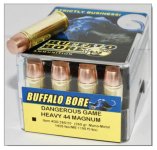 FF0ACEAD-C8F6-40A3-93A9-4E3F728EE2BE.jpg77.7 KB · Views: 68
FF0ACEAD-C8F6-40A3-93A9-4E3F728EE2BE.jpg77.7 KB · Views: 68 -
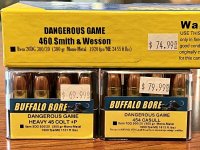 4D729189-EB15-449C-AA98-BFC26B88C6B8.jpg101.8 KB · Views: 62
4D729189-EB15-449C-AA98-BFC26B88C6B8.jpg101.8 KB · Views: 62 -
 87FF21D1-FEE7-49B7-8E7D-A2C5D4A6631F.jpg65.8 KB · Views: 70
87FF21D1-FEE7-49B7-8E7D-A2C5D4A6631F.jpg65.8 KB · Views: 70 -
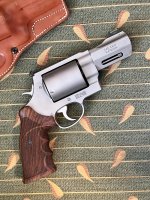 FDA3DA98-F0F7-408A-8BC9-07A5D0210AB8.jpg167.1 KB · Views: 114
FDA3DA98-F0F7-408A-8BC9-07A5D0210AB8.jpg167.1 KB · Views: 114 -
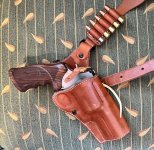 7F0CA518-25B5-4793-903D-35987D0CA0D8.jpg250.9 KB · Views: 87
7F0CA518-25B5-4793-903D-35987D0CA0D8.jpg250.9 KB · Views: 87
Last edited:


